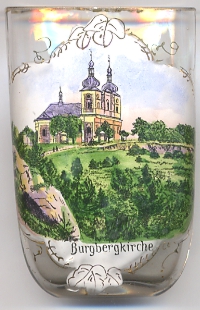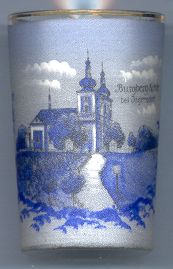

|
| ČESKÁ REPUBLIKA | CZECH REPUBLIC |
| Moravskoslezský kraj | North Moravia and Silesia (Ostrava) region |
| Okres: Bruntál |
Krnov (German: Jägerndorf) is situated at an elevation of 332 m at the confluence of the rivers Opava (Oppa) and Opavice (Goldoppa) in the extreme north of the Bruntál district of the Moravskoslezský region, directly at the border to Poland.
The earliest traces of settlements date from the Stone Age period of around 3000 BC. One of them was located on the Cvilín (Burgberg) hill above Krnov. The earliest document mentioning Völkisch Kyrnov dates from 1240. The name Jegerdorf was used at least from 1253. Documents of the Middle Ages refer to Krnov usually with its Latin name, Carnovia. It is not known when Krnov was chartered as a town, but these privileges were confirmed in a document of 1279. The castle Cvilín was founded in the 13th century and became a seat in the duchy of Opava (Troppau). In 1377, the duchy was divided and Krnov (Jägerndorf) became a separate duchy, which soon came in possession of the dukes of Opole (Oppeln). The ownership changed frequently during the following two centuries until in 1523 Margraves of Brandenburg-Ansbach from the House of Hohenzollern purchased the duchy and introduced the Reformation. During the Thirty Years' War (1618–1648) Krnov was devastated consecutively by Danish, Imperial, and Swedish troops. After the Battle at the White Mountain (Bílá Hora, today part of Prague) in 1622 the domains of the Hohenzollern were confiscated and given to the Princes of Liechtenstein, who immediately re-introduced Catholicism in their new duchy. After the Peace of Wrocław (Breslau) in 1742, the northern part of the duchy with Leobschütz (today Głubczyce, Poland) became part of Prussian Silesia, while the southern parts remained part of the Austrian countries. The Princes of Liechtenstein then re-united the two duchies of Opava/Troppau and Krnov/Jägerndorf. However, the importance of the town declined rapidly since the central administration for Austrian Silesia was set up at Opava (Troppau). The duchy of Jägerndorf as an entity expired in 1849. The Liechtenstein family owned the domains until 1945 (see Vaduz).
During the 19th century, Jägerndorf became a centre of textile industry. However, it also became famous as the seat of the world-known organ-builder manufacture of Franz Rieger, who opened his company in 1844. Towards the end of World War II most of the German-speaking inhabitants left the town. The remaining German inhabitants were expelled in 1946/1947.


The  pilgrimage church of Our Lady of Sorrow [left] on the Cvilín hill
was built in 1722–1727 in Baroque style.
pilgrimage church of Our Lady of Sorrow [left] on the Cvilín hill
was built in 1722–1727 in Baroque style.
![[scale]](lineal.jpg)